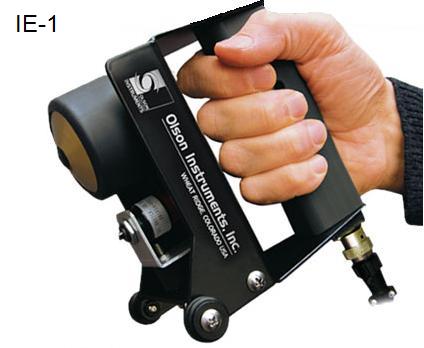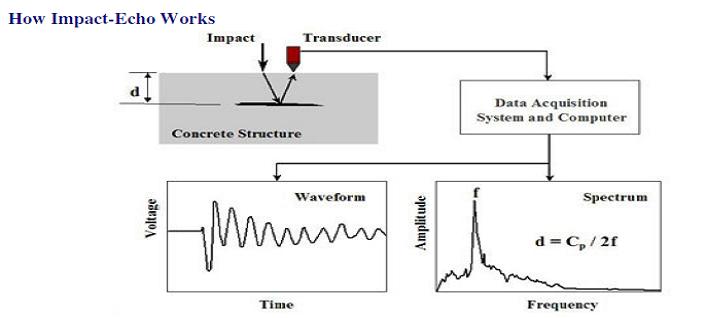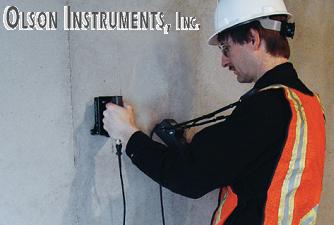Impact Echo
Impact Echo (IE) investigations are performed to access the condition of slabs, beams, walls, pavements, runways, tunnels and dams.
In its simplest form it is used for measuring the thickness of concrete elements from one-side. It can also be used to find concrete voids, honeycombing, cracks, delaminations, and other damage in concrete, giving depth, lateral location and extent of a flaw or defect.
Applications
The applications for the impact echo test are varied:
- Thickness measurement of slabs and walls
- Quality assurance for tunnel, and tunnel linings
- Investigating structures that suffer from issues due to poor concrete placement
- Investigation of damage to structures
- Delamination detection, such as from corrosion of steel in concrete
- Dilapidation surveys
- Void detection in grouted post-tensioning ducts
Impact Echo Test Configurations
The CTG-2 is a dedicated system used for Impact Echo concrete thickness measurement and concrete defect analysis exclusively.
Alternatively three sensor configurations are available for use with the Freedom Data PC or NDE 360.
These platforms allow the IE module to be added to the system and the user to select additional acoustic testing modules as they go.
Concrete Thickness Gauge 2
For simple investigations on slabs, pipes, or walls where the overall thickness is the primary concern, Olson Instruments manufactures a hand-held Concrete Thickness Gauge (CTG) based on the IE principle.
The CTG-2 quickly and easily provides the thickness of an unknown concrete elements and a raw frequency spectrum for advanced interpretation. The system uses a self contained Test Head with a dedicated link to any PC or windows tablet that display concrete thickness within seconds. See here for more information...
IE-1
 The IE-1 system combines the Olson's test-head with automatic solenoid impactor with the NDE 360 or Freedom Data PC. The test-head essentially makes the project a one man job. It is useful for elements up to 400mm. A secondary impactor (ie hammer) can be used for greater thicknesses. Both platform’s firmware allow multiple tests to be averaged for greater accuracy. The IE-1 Test Head is shown at the right.
The IE-1 system combines the Olson's test-head with automatic solenoid impactor with the NDE 360 or Freedom Data PC. The test-head essentially makes the project a one man job. It is useful for elements up to 400mm. A secondary impactor (ie hammer) can be used for greater thicknesses. Both platform’s firmware allow multiple tests to be averaged for greater accuracy. The IE-1 Test Head is shown at the right.
IE-2
The IE-2 system offers the Olson test-head with an additional accelerometer. This is particularly useful when investigating thicker structures.
IES
![Impact Echo Scanner test head [IES] Impact Echo Scanner, IES,](/images/impact-echo-australian-NDT.jpg) For large area investigations the Impact Echo Scanner is available. The system combines a split ring transducer and wheel into the test-head. By rolling the test-head across the concrete surface data is recorded in 25mm increments. This is particularly useful when investigation large surfaces or locating voids in post-tensioned ducts. The IES Test Head shown right.
For large area investigations the Impact Echo Scanner is available. The system combines a split ring transducer and wheel into the test-head. By rolling the test-head across the concrete surface data is recorded in 25mm increments. This is particularly useful when investigation large surfaces or locating voids in post-tensioned ducts. The IES Test Head shown right.
Advantages over other NDTs
The system affords the following benefits to the user:
- Only one surface needs to be accessible for testing.
- Quickly provides thickness of an unknown member, without coring.
- Detects defects such as concrete voids, concrete honeycomb, cracks and delaminations.
- Location of the defects depth and lateral location
- Can be used to predict early age strength
The Impact Echo Method - How it Works
The impact is a short-duration mechanical tap, produced by tapping a small steel sphere or solenoid (in the case of the Olson test-head) against a concrete or masonry Surface. This produces low-frequency stress waves (up to about 80 kHz) that propagate into the structure and are reflected by flaws and/or external surfaces.
The wavelengths of these stress waves are typically between 70mm and 2m -- longer than the scale of natural inhomogeneous regions in concrete (aggregate, air bubbles, micro-cracks, etc.). As a result they are only weakly distorted, and propagate through concrete almost as though it were a homogeneous elastic medium.
Multiple reflections of these waves within the structure excite local modes of vibration, and the resulting surface displacements are recorded by a transducer located adjacent to the impact. The IE time traces are transformed to the frequency domain via FFT for calculations of the transfer and coherence functions, and the auto power spectrum of the receiver. Spectrum data represents resonant frequencies and are used to determine the depth of reflectors according to the following equation:
d = Cp / 2f
Where d is the reflector depth, f is the highest amplitude frequency peak identified in the response, and Cp is the compressional wave velocity (upv or p-wave velocity). Which must be determined via a site based calibration.





